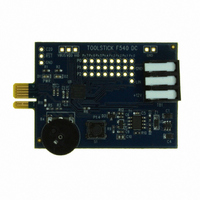TOOLSTICK540DC Silicon Laboratories Inc, TOOLSTICK540DC Datasheet - Page 258

TOOLSTICK540DC
Manufacturer Part Number
TOOLSTICK540DC
Description
DAUGHTER CARD TOOLSTICK F540
Manufacturer
Silicon Laboratories Inc
Series
ToolStickr
Type
MCUr
Datasheets
1.TOOLSTICK540DC.pdf
(274 pages)
2.TOOLSTICK540DC.pdf
(16 pages)
3.TOOLSTICK540DC.pdf
(12 pages)
Specifications of TOOLSTICK540DC
Contents
Daughter Card
Processor To Be Evaluated
C8051F54x
Processor Series
C8051F54x
Interface Type
USB
Operating Supply Voltage
2.7 V to 3.6 V
Lead Free Status / RoHS Status
Lead free / RoHS Compliant
For Use With/related Products
C8051F54x
For Use With
336-1345 - TOOLSTICK BASE ADAPTER336-1182 - ADAPTER USB DEBUG FOR C8051FXXX
Lead Free Status / Rohs Status
Lead free / RoHS Compliant
Other names
336-1717
- Current page: 258 of 274
- Download datasheet (3Mb)
C8051F54x
24.3.5.2. 9/10/11-bit Pulse Width Modulator Mode
The duty cycle of the PWM output signal in 9/10/11-bit PWM mode should be varied by writing to an “Auto-
Reload” Register, which is dual-mapped into the PCA0CPHn and PCA0CPLn register locations. The data
written to define the duty cycle should be right-justified in the registers. The auto-reload registers are
accessed (read or written) when the bit ARSEL in PCA0PWM is set to 1. The capture/compare registers
are accessed when ARSEL is set to 0.
When the least-significant N bits of the PCA0 counter match the value in the associated module’s cap-
ture/compare register (PCA0CPn), the output on CEXn is asserted high. When the counter overflows from
the Nth bit, CEXn is asserted low (see Figure 24.9). Upon an overflow from the Nth bit, the COVF flag is
set, and the value stored in the module’s auto-reload register is loaded into the capture/compare register.
The value of N is determined by the CLSEL bits in register PCA0PWM.
The 9, 10 or 11-bit PWM mode is selected by setting the ECOMn and PWMn bits in the PCA0CPMn regis-
ter, and setting the CLSEL bits in register PCA0PWM to the desired cycle length (other than 8-bits). If the
MATn bit is set to 1, the CCFn flag for the module will be set each time a comparator match (rising edge)
occurs. The COVF flag in PCA0PWM can be used to detect the overflow (falling edge), which will occur
every 512 (9-bit), 1024 (10-bit) or 2048 (11-bit) PCA clock cycles. The duty cycle for 9/10/11-Bit PWM
Mode is given in Equation 24.2, where N is the number of bits in the PWM cycle.
Important Note About PCA0CPHn and PCA0CPLn Registers : When writing a 16-bit value to the
PCA0CPn registers, the low byte should always be written first. Writing to PCA0CPLn clears the ECOMn
bit to 0; writing to PCA0CPHn sets ECOMn to 1.
A 0% duty cycle may be generated by clearing the ECOMn bit to 0.
258
PCA0CPLn
Write to
Reset
PCA0CPHn
R
A
S
E
L
0
Write to
C
O
PCA0PWM
E
V
C
O
V
F
x
0
ENB
ENB
1
C
L
S
E
L
1
0
C
L
S
E
L
0
0
W
M
P
1
6
n
0
Equation 24.3. 9, 10, and 11-Bit PWM Duty Cycle
E
C
O
M
n
PCA0CPMn
C
A
P
P
n
0 0 x 0
Figure 24.8. PCA 8-Bit PWM Mode Diagram
C
A
P
N
n
M
A
T
n
O
G
T
n
W
M
P
n
C
C
E
F
n
x
PCA Timebase
Duty Cycle
Enable
=
PCA0CPHn
Comparator
PCA0CPLn
Rev. 1.1
PCA0L
----------------------------------------------- -
8-bit
2 N PCA0CPn
–
2 N
Overflow
COVF
match
S
R
SET
CLR
Q
Q
CEXn
Crossbar
Port I/O
Related parts for TOOLSTICK540DC
Image
Part Number
Description
Manufacturer
Datasheet
Request
R

Part Number:
Description:
KIT TOOL EVAL SYS IN A USB STICK
Manufacturer:
Silicon Laboratories Inc
Datasheet:

Part Number:
Description:
TOOLSTICK DEBUG ADAPTER
Manufacturer:
Silicon Laboratories Inc
Datasheet:

Part Number:
Description:
TOOLSTICK BASE ADAPTER
Manufacturer:
Silicon Laboratories Inc
Datasheet:

Part Number:
Description:
TOOLSTICK DAUGHTER CARD
Manufacturer:
Silicon Laboratories Inc
Datasheet:

Part Number:
Description:
TOOLSTICK DAUGHTER CARD
Manufacturer:
Silicon Laboratories Inc
Datasheet:

Part Number:
Description:
TOOLSTICK DAUGHTER CARD
Manufacturer:
Silicon Laboratories Inc
Datasheet:

Part Number:
Description:
TOOLSTICK PROGRAMMING ADAPTER
Manufacturer:
Silicon Laboratories Inc
Datasheet:

Part Number:
Description:
TOOLSTICK DAUGHTER CARD
Manufacturer:
Silicon Laboratories Inc
Datasheet:

Part Number:
Description:
KIT STARTER TOOLSTICK
Manufacturer:
Silicon Laboratories Inc
Datasheet:

Part Number:
Description:
KIT UNIVERSITY TOOLSTICK STARTER
Manufacturer:
Silicon Laboratories Inc
Datasheet:

Part Number:
Description:
DAUGHTER CARD TOOLSTICK F330
Manufacturer:
Silicon Laboratories Inc
Datasheet:

Part Number:
Description:
CARD DAUGHTER UNIVRSTY TOOLSTICK
Manufacturer:
Silicon Laboratories Inc
Datasheet:

Part Number:
Description:
DAUGHTER CARD TOOLSTICK F582
Manufacturer:
Silicon Laboratories Inc
Datasheet:

Part Number:
Description:
DAUGHTER CARD TOOLSTICK F500
Manufacturer:
Silicon Laboratories Inc
Datasheet:

Part Number:
Description:
DAUGHTER CARD TOOLSTICK F560
Manufacturer:
Silicon Laboratories Inc
Datasheet:










